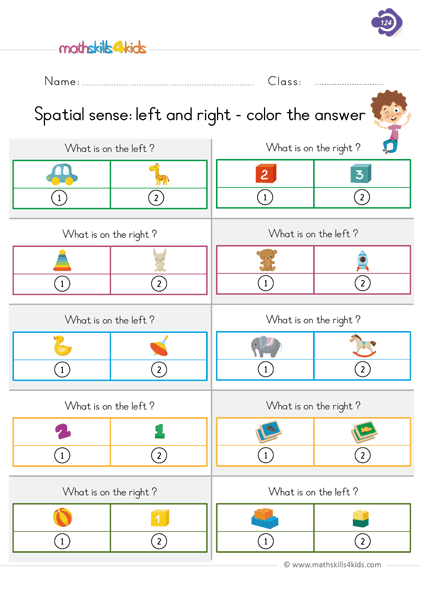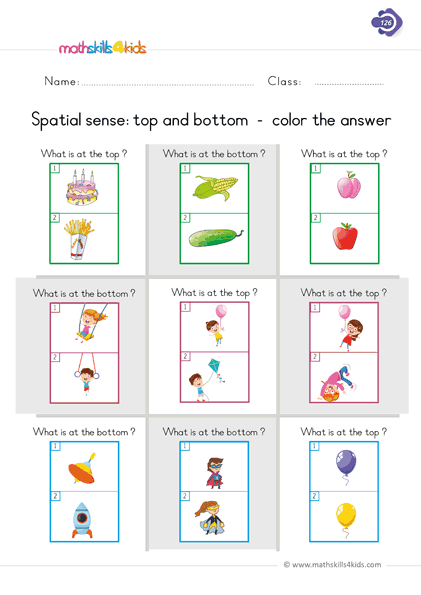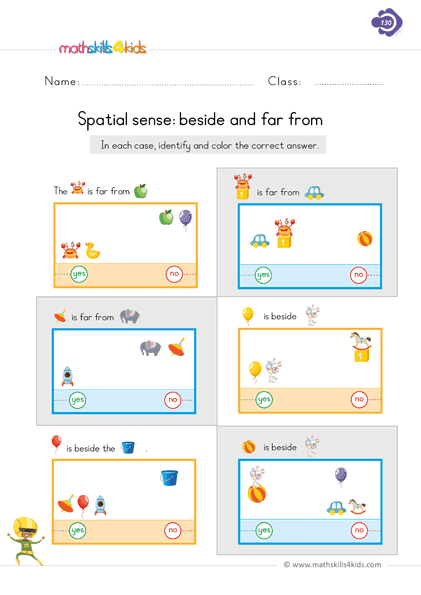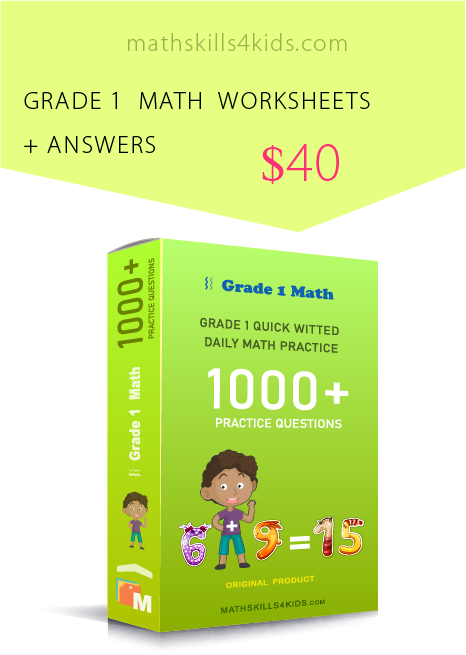Spatial relations worksheets for first Grade: Printable and Free
Are you looking for ways to help your first grader develop their spatial relations skills? If so, you've come to the right place! In this thrilling resource, we'll explain what spatial relations are, why they are important for your child's learning and development, how to assess your child's current level of spatial relations abilities, and how to use free and fun spatial relations worksheets for first Grade to boost their skills.
Let's get started!
-
Why spatial relations skills are important for first graders
There are many reasons why spatial relations skills are important for first graders. Let's find out below.
Spatial relations skills are the ability to perceive and understand the position and movement of objects in space relative to oneself and each other. These skills are essential for everyday tasks, such as reading, writing, math, sports, navigation, and more.
For first graders, spatial relations skills are essential for developing their visual-motor integration, which is the coordination of visual perception and motor skills.
Visual-motor integration enables your child to copy shapes and letters, write within lines, cut with scissors, draw pictures, and complete puzzles. These activities are crucial for building your child's academic readiness and confidence.
Moreover, spatial relations skills also help your child develop spatial reasoning, which is the ability to manipulate and transform mental images of objects and shapes. Spatial reasoning is crucial to geometry, algebra, physics, engineering, and other STEM fields. By fostering your child's spatial reasoning skills early on, you can prepare them for future success in these domains.
-
BROWSE THE WEBSITE
-
DOWNLOAD FREE WORKSHEETS
-
-
1st GRADE MATH TOPICS
- Counting and numbers
- Understand addition
- Addition skills
- Addition exercises
- Addition strategies
- Understand subtraction
- Subtraction skills
- Subtraction Exercises
- Subtraction strategies
- Mixed operation
- Comparing numbers up to 100
- Estimation Worksheets
- Place value
- Spatial sense
- Graphing & data
- Measurement
- Patterns
- Probability
- Sorting & classifying
- Telling time
- 2D shapes
- 3D shapes - Solids figures
- Fractions
-
-
How to assess your child's spatial relations abilities
Before using spatial relations worksheets for first Grade, you should assess your kid's current spatial relations abilities. This can help you identify their strengths and weaknesses and tailor the worksheets accordingly.
There are many ways to assess your child's spatial relations abilities. Still, one simple and effective method is to use the Spatial Relations subtest from the Test of Visual Perceptual Skills (TVPS). This subtest consists of 16 items that measure your child's ability to match a target shape with one of four choices that differ in orientation or position. The items increase in difficulty as the test progresses.
To administer the Spatial Relations subtest, you will need a copy of the TVPS manual, a stimulus book, and a response booklet. You can purchase these materials online or borrow them from a school or library. You will also need a pencil and a stopwatch.
To score the Spatial Relations subtest, you must compare your child's responses with the answer key provided in the manual. You will also need to use the norm tables in the manual to convert your child's raw score into a standard score based on their age group.
A standard score of 100 is average, while a standard score below 85 indicates a possible difficulty with spatial relations.
-
How can these worksheets be used in the classroom or at home?
Our spatial relations worksheets for first Grade are perfect for classroom use, home use, independent practice, or review with your kids. Let's find out how to use them.
You can also use them as part of a center activity, a small group lesson, or a whole class discussion.
These worksheets are designed to help your first graders develop their spatial awareness and vocabulary.
Here are some tips on how to use these worksheets effectively:
- Before giving out the worksheets, review the key terms and concepts related to spatial relations with your students.
You can use posters, flashcards, manipulatives, or real-life examples to illustrate the meaning of words like above, below, next to, between, inside, outside, etc.
- Encourage your students to use the correct spatial terms when describing the pictures or answering the questions on the worksheets. For example;
Instead of saying, "The cat is here," they should say, "The cat is under the table."
- Please provide feedback and reinforcement to your students as they complete the worksheets. You can check their answers, praise their efforts, correct their mistakes, or ask them to explain their reasoning.
- Extend the learning by asking your students to apply their spatial skills to other situations or contexts. For example;
You can ask them to describe where they are sitting in the classroom, their favorite toy in their bedroom, or how they get to school from their house.
- Before giving out the worksheets, review the key terms and concepts related to spatial relations with your students.
-
What are some examples of the types of spatial relations covered in these worksheets?
These worksheets cover a range of spatial relations that are important for your first graders to learn and master. Here are some examples of the types of spatial relations covered in these worksheets:
- Position: This refers to where an object is located about another object or a reference point. For example, the bird is on the tree; the book is in the backpack, and the ball is behind the chair.
- Direction: This refers to where an object moves or faces another object or a reference point. For example, the car is going left; the arrow is pointing up, and the dog is facing right.
- Movement: This refers to how an object changes its position or direction over time or space. For example, a plane flies across the sky; a train moves along the track, and a frog jumps over a log.
-
Tips and tricks to help your child improve their spatial relations skills
If your child needs some extra help with their spatial relations skills, don't worry! There are many tips and tricks that you can use to make learning fun and engaging for them.
Here are some ideas:
- Play games that involve spatial concepts, such as Simon Says, Twister, I Spy, Memory, Tetris, Tangrams, etc.
- Use manipulatives such as blocks, Lego bricks, pattern blocks, etc., to build structures and shapes with your child. Ask them to describe what they are making using words like above, below, next to, inside, outside, etc.
- Draw or trace shapes and letters using different orientations and positions with your child. For example, you can draw a triangle upside down, sideways, or rotated.
You can also trace letters on your child's back or palm and ask them to guess what they are.
- Use mirrors or paper folding to show your child how shapes and objects can be reflected or symmetrical. For example;
You can fold a piece of paper in half and cut out a shape along the fold. Then unfold the paper and show your child how the shape is symmetrical on both sides.
- Use maps or models to teach your child about directions and locations. For example, you can use a map of your neighborhood or school and ask your child to point out where they live, where they go to school, where the park is, etc.
You can also use a car or house model and ask your child to identify the front, back, left, right, top, bottom, etc.
-
How to use spatial relations worksheets effectively and creatively
To get the most out of spatial relations worksheets for first Grade, you should use them effectively and creatively with your child.
Here are some tips on how to do that:
- Choose worksheets that are appropriate for your child's difficulty and interest level. You can start with more accessible worksheets and gradually increase the challenge as your child progresses.
You can also choose worksheets that match your child's hobbies or preferences, such as animals, sports, cars, etc.
- Please review the instructions and examples with your child before they start working on the worksheets. Ensure they understand what they should do and how to do it.
You can also model the task for them or do it with them at first.
- Please provide feedback and encouragement to your child as they work on the worksheets. Praise them for their efforts and achievements, and point out their mistakes gently and constructively. Help them correct their errors and explain why they are wrong.
You can also ask them questions to check their understanding and reasoning.
- Make the worksheets more fun and interactive by using different materials or tools. For example, you can use stickers, stamps, crayons, markers, scissors, glue, etc., to decorate or complete the worksheets.
You can also use a timer, a spinner, a dice, etc., to add some randomness or excitement to the worksheets.
- Extend the learning beyond the worksheets by applying the concepts to real-life situations. For example, you can ask your child to find shapes in their environment, such as in their room, toys, clothes, etc.
You can also ask them to create their own shapes or patterns using different objects or materials.
- Choose worksheets that are appropriate for your child's difficulty and interest level. You can start with more accessible worksheets and gradually increase the challenge as your child progresses.
Where to find free and fun spatial relations worksheets for first grade
One of the best ways to practice and improve your child's spatial relations skills is to use spatial relations worksheets for First Grade. These worksheets are designed to challenge your child's visual perception and spatial reasoning skills in a fun and engaging way.
Many websites offer free and printable spatial relations worksheets for first Grade, such as:
- https://www.education.com/worksheets/first-grade/geometry/
- https://www.k5learning.com/free-math-worksheets/first-grade-1/geometry
- https://www.math-salamanders.com/1st-grade-geometry.html
- https://www.mathworksheets4kids.com/spatial-reasoning.php
These websites have a variety of worksheets that cover topics such as:
- Identifying and naming shapes
- Comparing and sorting shapes by size, color, or type
- Finding shapes in pictures or patterns
- Drawing or completing shapes
- Matching or finding congruent or similar shapes
- Rotating or flipping shapes
- Finding the perimeter or area of shapes
- Finding the missing piece or part of a shape
- Solving puzzles or mazes involving shapes
Thank you for sharing the links of MathSkills4Kids.com with your loved ones. Your choice is greatly appreciated.
-
In conclusion, note that spatial relations skills are essential for your first grader's learning and development. By using spatial relations worksheets for first Grade, you can help your child practice and improve these skills in a fun and engaging way.
We hope this article has given you some helpful information and resources on how to use spatial relations worksheets effectively and creatively with your child.
Happy learning! Perfect for at-home learning or in the classroom.




